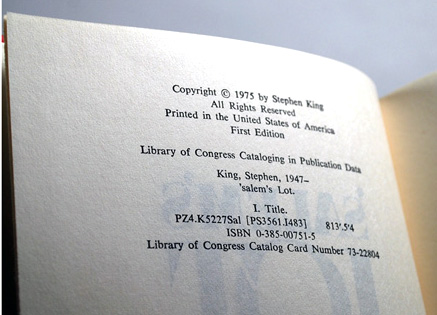There are many reasons to collect books and many different versions of books to collect. But if you are looking to build a library that will appreciate in value over time and bring you as close as you can get to the book the author intended his readers to read, it makes sense to only collect first editions.
First editions may not seem a practical choice, given their sometimes steep prices, but owning a rare book few others own and being able to cherish it in your own personal library can outweigh the impracticality of the purchase. Here are the top six reasons why true book collectors consider first editions to be the only editions worth buying.

1. Appreciating Investments
When you purchase a reprint of a book, especially a paperback version, you will never regain your initial financial investment. Granted, that investment may only be $5.99 or so, but if you ever go to resell that reprint, the most you will probably get is fifty cents at your next yard sale. Contrast that with the purchase of a first edition. The initial financial investment for many first editions is much more substantial than $5.99. The price tag could be in the hundreds, even thousands, of dollars. But if you hold on to that first edition, keep up its condition, and find the right buyer at the right time, you are likely to realize a profit.
2. Short Supply, High Demand
Because they are a rare species, first editions can be costly. While there is a first edition of every book, not all first editions are actively collected. Books that were collected a half century ago may not be sought after today. Demand for a book is what drives the book collecting market, so if there is no interest in a particular book, the value of that first edition will decrease. But if a book is still being hunted by collectors, either because of a famous author or because of personal interest, chances are that the value of the first edition has appreciated over the past half century.
3. Artistic Superiority
First editions are also valued over reprints for artistic reasons. In older printing presses, the letters used in the plate were made from wood or soft metals. This meant that subsequent press runs would be inferior to the first press. The first press run produced the clearest type on the book pages. With current offset presses, legibility on any run is not an issue, but the convention of coveting a first edition is still standard book collecting practice today.
4. Authenticity
Collectors also revere first editions because they are the closest readers can get to the intended manuscript penned by the author. A first edition is the layout, typeface, and cover design originally chosen by the publisher and author. Collectors even cherish any unintentional errors in the first edition. Subsequent reprints will correct any errors found in the first edition, and perhaps there has been new text or new forewords added. These issues further remove the reprint from the original intended work.
5. Risky Business
The First Edition of the author’s first book.
There is an underlying spirit of risk in a first edition. Not knowing if the book would sell well, the publisher took a chance on the author. If there are reprints, that means the book is selling well, and those copies are already accounted for by bookstores looking to fill the demand from their customers. A first edition is a symbol of the publisher’s faith in the author and his manuscript.
Some non-collectors, and even rookie collectors, do not understand why first editions are so highly coveted. Some may even prefer a shiny, crisp new copy to an old, musty, perhaps slightly used version of the same book. After all, the content is the same. But if you think of book collecting as an investment in terms of both financial and personal rewards, first editions are much more likely to appreciate in value over time.
6. Perception is Realty.
The mere perception that something is more valuable creates a market-place of book collectors that are willing to pay a much higher price for a first edition. This is true assuming it is original , authentic, and in great condition. The price of a collectible is determined by what any individual buyer is willing to pay for it at any given time.
Looking for something special for your library? Peruse through our new arrivals now.

Leave a Reply